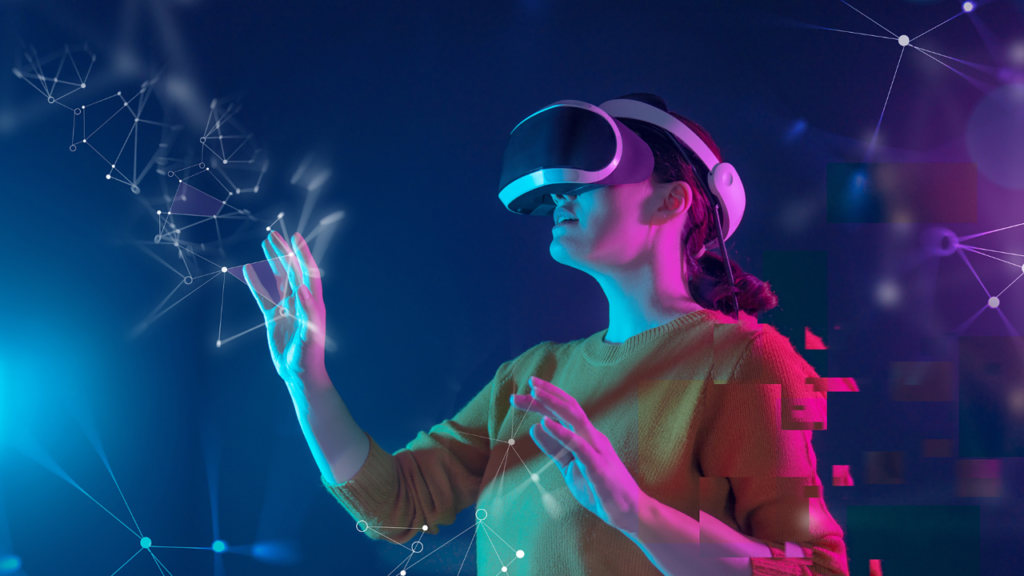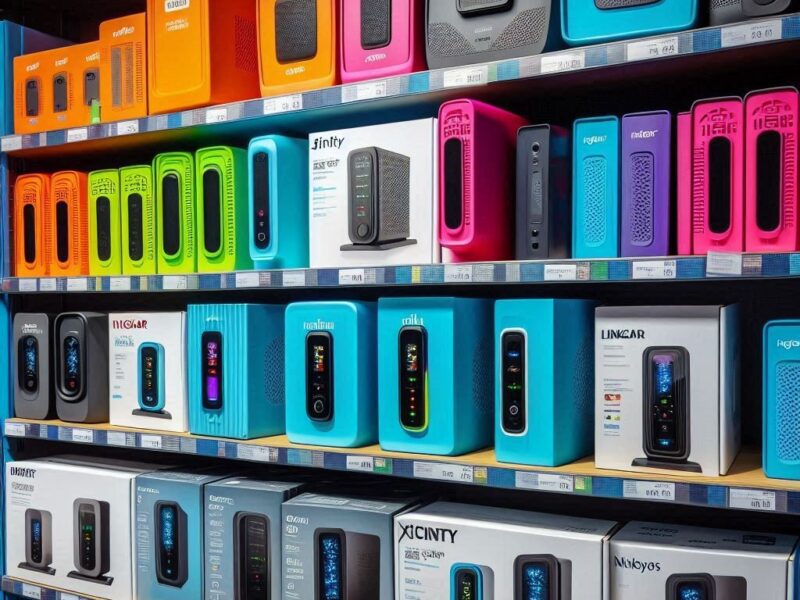
Metaverse gains traction with VR, AR, and blockchain advancements. Often described as a collective virtual shared space, the metaverse represents the convergence of physical and digital realities, offering new opportunities for social interaction, entertainment, education, and commerce. This comprehensive exploration delves into the future of the metaverse, examining its potential impacts, technological underpinnings, and the societal changes it may bring.
1. Introduction to the Metaverse
The term “metaverse” was coined by Neal Stephenson in his 1992 science fiction novel “Snow Crash,” where it described a virtual reality-based successor to the internet. Today, the metaverse is envisioned as a network of 3D virtual worlds focused on social connection, a virtual universe where users can interact with each other and the environment in real-time.
1.1 Defining the Metaverse
Metaverse: A collective virtual space, blurring the lines between reality and the digital realm. It’s characterized by:
– Interoperability: Seamless movement between different virtual spaces and applications.
– Persistence: Continuity in virtual environments, where changes and interactions persist over time.
– Synchronicity: Real-time interactions between users and the virtual environment.
– User-generated Content: Significant contributions from users in creating and shaping the virtual spaces.
2. Technological Foundations
The development and expansion of the metaverse rely on several key technologies, each contributing to the immersive and interactive nature of this virtual space.
2.1 Virtual Reality (VR) and Augmented Reality (AR)
VR and AR are the cornerstones of the metaverse, enabling users to experience and interact with virtual environments in immersive ways.
– Virtual Reality (VR): VR technology creates a fully immersive digital environment that users can interact with through VR headsets and motion controllers. Companies like Oculus (owned by Meta), HTC Vive, and PlayStation VR are leading the charge in VR hardware development.
– Augmented Reality (AR): AR overlays digital information onto the physical world, enhancing the user’s perception of reality. AR can be experienced through devices like smartphones, tablets, and AR glasses, with companies like Apple, Microsoft (HoloLens), and Google investing heavily in AR technology.
2.2 Blockchain and Decentralized Technologies
Blockchain technology plays a crucial role in the metaverse by providing the infrastructure for digital ownership, identity verification, and secure transactions.
– Digital Ownership: Non-fungible tokens (NFTs) enable users to own unique digital assets within the metaverse, from virtual real estate to digital art and collectibles.
– Decentralized Economies: Blockchain-based cryptocurrencies facilitate transactions within the metaverse, creating decentralized economies that operate independently of traditional financial systems.
– Smart Contracts: Automated, self-executing contracts stored on the blockchain ensure trust and transparency in virtual transactions and interactions.
2.3 Artificial Intelligence (AI)
AI enhances the metaverse by enabling more realistic and responsive virtual environments and characters.
– Virtual Assistants: AI-powered virtual assistants can guide users through the metaverse, offering personalized experiences and support.
– Content Generation: AI algorithms can create dynamic and interactive content, such as procedural generation of virtual worlds and realistic simulations.
– Behavioral AI: AI-driven non-player characters (NPCs) can exhibit lifelike behaviors and interactions, enhancing the realism of virtual environments.
2.4 Networking and Cloud Computing
While robust networking and cloud infrastructure are foundational for the metaverse, let’s delve deeper into the specific requirements to create seamless real-time interactions and vast virtual spaces.
– Low Latency Networks: High-speed internet and 5G networks are critical for ensuring smooth, real-time interactions within the metaverse.
– Cloud Computing: Cloud platforms like Amazon Web Services (AWS), Microsoft Azure, and Google Cloud provide the scalable computing power needed to render complex virtual worlds and manage large user bases.
3. Potential Impacts of the Metaverse
The metaverse holds the potential to transform various aspects of society, from social interactions and entertainment to education and commerce.
3.1 Social Interaction and Community Building
The metaverse can revolutionize how people connect and build communities, offering new ways to interact and socialize.
– Virtual Social Spaces: Platforms like VRChat, AltspaceVR, and Meta’s Horizon Worlds enable users to create and join virtual communities, participating in events, games, and social gatherings.
– Enhanced Communication: Immersive communication tools, such as virtual meeting rooms and holographic telepresence, can facilitate more engaging and effective interactions, especially in remote work and collaboration settings.
– Inclusivity and Accessibility: The metaverse can provide inclusive spaces where individuals with physical disabilities or geographical constraints can participate fully in social, educational, and professional activities.
3.2 Entertainment and Media
The entertainment industry is poised for significant disruption and innovation through the metaverse.
– Virtual Concerts and Events: Metaverse concerts: Global audiences, immersive experiences.” For example, Fortnite’s virtual concerts with artists like Travis Scott and Ariana Grande attracted millions of viewers.
– Immersive Gaming: Gaming leads the metaverse charge with Roblox, Minecraft, and Second Life.
– Interactive Storytelling: The metaverse allows for new forms of interactive storytelling, where users can influence the narrative and experience stories from multiple perspectives.
3.3 Education and Training
The metaverse offers transformative potential for education and training, making learning more interactive and accessible.
– Virtual Classrooms: Virtual classrooms and campuses can provide immersive learning experiences, allowing students to attend lectures, collaborate on projects, and engage in simulations from anywhere in the world.
– Skill Development: The metaverse offers realistic hands-on training in fields like medicine and engineering.
– Lifelong Learning: The metaverse enables continuous learning through tailored courses and training programs.
3.4 Commerce and the Economy
The metaverse is set to reshape commerce, creating new economic opportunities and business models.
– Virtual Marketplaces: Buy, sell, trade virtual goods and services.
– Brand Engagement: Brands can create immersive marketing campaigns and virtual storefronts, engaging with customers in novel and interactive ways.
– Remote Work and Collaboration: “Metaverse enhances remote work with immersive virtual offices and collaboration tools, boosting engagement and productivity.”
3.5 Real Estate and Urban Planning
The concept of virtual real estate is gaining traction, with users buying and developing virtual land in the metaverse.
– Virtual Real Estate: Decentral and The Sandbox offer virtual real estate for purchase and monetization.
– Urban Planning: Metaverse serves as a testing ground for urban planning, allowing architects to create and explore virtual city models.
4. Challenges and Considerations
While the metaverse holds immense potential, several challenges and considerations must be addressed to ensure its successful development and adoption.
4.1 Technical Challenges
Creating a fully realized metaverse presents numerous technical challenges that must be overcome.
– Scalability: Metaverse scalability demands advancements in networking, computing, and data storage to support millions of users.
– Interoperability: Seamless movement between different virtual spaces and platforms necessitates the development of standardized protocols and frameworks for interoperability.
– User Experience: Delivering a consistent and high-quality user experience across diverse devices and platforms is essential for widespread adoption.
4.2 Privacy and Security
The metaverse introduces new concerns regarding privacy and security that must be addressed to protect users and their data.
– Data Privacy: The collection and use of personal data within the metaverse must be managed responsibly, with robust privacy protections and user consent mechanisms.
– Security: Ensuring the security of virtual assets, transactions, and interactions is critical to prevent fraud, hacking, and other malicious activities.
– Identity Verification: Developing reliable methods for identity verification and authentication within the metaverse is essential to prevent identity theft and ensure trust.
4.3 Ethical and Social Considerations
The metaverse raises important ethical and social questions that must be carefully considered.
– Digital Divide: Ensuring equitable access to the metaverse and its benefits is crucial to prevent further widening of the digital divide.
– Mental Health: The impact of prolonged immersion in virtual environments on mental health and well-being must be studied and addressed.
– Content Moderation: Developing effective content moderation strategies is essential to prevent harmful and inappropriate content within the metaverse.
4.4 Legal and Regulatory Issues
The metaverse presents new legal and regulatory challenges that must be navigated to ensure its safe and fair development.
– Intellectual Property: Protecting intellectual property rights within the metaverse, including digital assets and creations, requires new legal frameworks and enforcement mechanisms.
– Regulation: Governments and regulatory bodies must develop policies and regulations to address issues such as digital ownership, taxation, and consumer protection within the metaverse.
– Jurisdiction: Determining jurisdiction and legal authority over virtual spaces and transactions poses complex challenges that require international cooperation and coordination.
5. The Road Ahead: Predictions and Possibilities
The future of the metaverse is a topic of great speculation and excitement, with numerous predictions and possibilities emerging as the technology evolves.
5.1 Short-Term Developments (Next 5 Years)
In the short term, we can expect several key developments that will shape the early stages of the metaverse.
– Enhanced Hardware: Continued advancements in VR and AR hardware, including more affordable and accessible devices, will drive greater adoption of the metaverse.
– Expanded Platforms: Existing metaverse platforms like Roblox, Decentraland, and Fortnite will continue to grow, attracting more users and content creators.
– Interoperability Standards: The development of interoperability standards and protocols will enable more seamless integration between different virtual spaces and platforms.
5.2 Medium-Term Developments (Next 10 Years)
Over the next decade, the metaverse will undergo significant transformations as technology and societal adoption advance.
– Mainstream Adoption: The metaverse will become more mainstream, with widespread use across various sectors, including entertainment, education, commerce, and healthcare.
– Virtual Economies: The emergence of robust virtual economies, supported by blockchain and cryptocurrency technologies, will create new opportunities for entrepreneurship and innovation.
– AI Integration: Greater integration of AI technologies will enhance the realism and interactivity of the metaverse, enabling more sophisticated virtual environments and experiences.
5.3 Long-Term Developments (Beyond 10 Years)
In the long term, the metaverse has the potential to fundamentally reshape society and the way we live, work, and interact.
– Seamless Integration: The metaverse will become seamlessly integrated into our daily lives, blurring the lines between physical and digital realities.
– New Social Norms: The metaverse will give rise to new social norms and behaviors, as virtual interactions and experiences become an integral part of human culture.
– Global Collaboration: The metaverse will facilitate unprecedented levels of global collaboration and innovation, enabling people from diverse backgrounds and locations to work together in virtual spaces.
6. Conclusion
The metaverse beckons a future where our physical and digital worlds merge, sparking new ways to connect, create, and innovate. However, as we navigate the challenges and opportunities of this emerging virtual universe, it is essential to approach its development with a focus on inclusivity, privacy, and ethical considerations. By harnessing the power of technology and human ingenuity, the metaverse has the potential to enrich our lives and create a more connected and dynamic world
The journey to a fully realized metaverse is just beginning, and its future holds immense promise. As we continue to explore and shape this new frontier, the metaverse will undoubtedly redefine the boundaries of human experience and open up new horizons for discovery and collaboration.


All I know is that it is currently a wet fever dream of a billionaire and a dumpster fire at the same time.